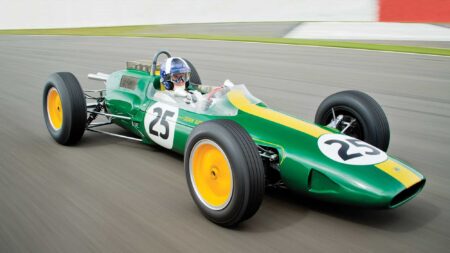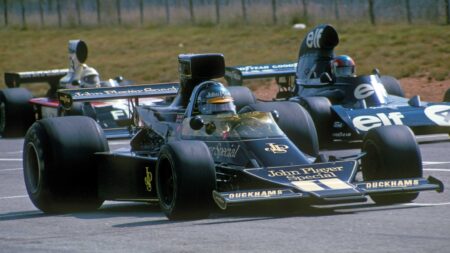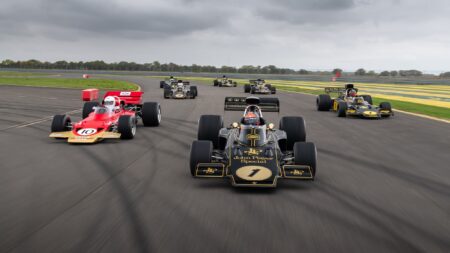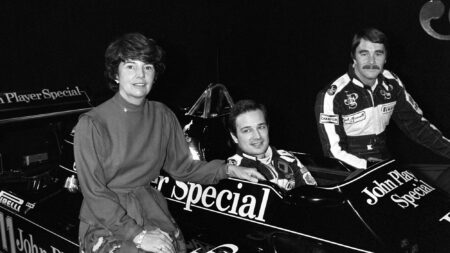Anthony Colin Bruce Chapman died 31 years ago this week. He was 54.  Peter Warr and Colin Chapman, 1982 He looked older. The toll exacted by a hectic life of all-nighters and no tea breaks insidiously ran deeper than his receding line of ghostly hair and sadly he suffered a fatal heart attack in the early hours of December 16, 1982. It was fitting that his beloved Team Lotus – the jewel in the crown – that same day rolled out its Next Big Thing: a Formula 1 Type 92-Cosworth equipped with active suspension, to be driven by rising Formula 3 star Dave Scott. It was entirely apt, too, that the control of this car’s suspension by computer was a Plan B. Solving problems was what made Chapman tick; the wins, money and fame that he enjoyed were by-products. Plan A, however, had tested his resolve and love for the sport to breaking point.
Peter Warr and Colin Chapman, 1982 He looked older. The toll exacted by a hectic life of all-nighters and no tea breaks insidiously ran deeper than his receding line of ghostly hair and sadly he suffered a fatal heart attack in the early hours of December 16, 1982. It was fitting that his beloved Team Lotus – the jewel in the crown – that same day rolled out its Next Big Thing: a Formula 1 Type 92-Cosworth equipped with active suspension, to be driven by rising Formula 3 star Dave Scott. It was entirely apt, too, that the control of this car’s suspension by computer was a Plan B. Solving problems was what made Chapman tick; the wins, money and fame that he enjoyed were by-products. Plan A, however, had tested his resolve and love for the sport to breaking point.
Twin-chassis innovation
The twin-chassis Type 88 of 1981 was a mechanical means of isolating the driver from the physical pounding meted out by suspensions stiffened beyond all ken to cope with unenvisioned forces generated by shaped underbodies. Ingenious, if a little chunky by Chapman’s usual standards – and, yes, I am familiar with the gargantuan Type 64 Indycar – it was constructed in great secrecy: separate groups working on they knew not what until chassis were united.  De Angelis in the 88 at Jacarepaguá, 1981 Rarely has a car received such a hostile reception. Its rivals, fearing another costly spell of technical catch-up, protested en masse. And won. Chapman’s hopes were in March tossed metaphorically into Long Beach harbour. Though he was still fighting this long lost cause in November, the stark truth was that he had been outflanked. By Bernie Ecclestone. Not only was the latter busy winning the FISA-FOCA peace versus Jean-Marie Balestre, but also his Brabham designer Gordon Murray – Chapman’s spiritual successor – was simultaneously concocting a simpler, cheaper way of skirting the banning of sliding skirts. Only the year before, Chapman had been in cahoots with Balestre, plotting a coup d’état against Ecclestone and a rapprochement with Enzo Ferrari. Upon his return from this potentially seismic meeting, however, he changed his mind. He no longer had the stomach for politics.
De Angelis in the 88 at Jacarepaguá, 1981 Rarely has a car received such a hostile reception. Its rivals, fearing another costly spell of technical catch-up, protested en masse. And won. Chapman’s hopes were in March tossed metaphorically into Long Beach harbour. Though he was still fighting this long lost cause in November, the stark truth was that he had been outflanked. By Bernie Ecclestone. Not only was the latter busy winning the FISA-FOCA peace versus Jean-Marie Balestre, but also his Brabham designer Gordon Murray – Chapman’s spiritual successor – was simultaneously concocting a simpler, cheaper way of skirting the banning of sliding skirts. Only the year before, Chapman had been in cahoots with Balestre, plotting a coup d’état against Ecclestone and a rapprochement with Enzo Ferrari. Upon his return from this potentially seismic meeting, however, he changed his mind. He no longer had the stomach for politics.
Chapman’s last F1 cars 80: Three starts, one third place 81: 38 starts, one second, one third 87: 21 starts, no podiums 88: Banned 91: 27 starts, one win, one third
With Team Lotus no longer winning with facility, Chapman’s F1 influence was beginning to wane on and off the track. Away from F1, the running of a large-scale company for the benefit of its shareholders was also beginning to pall. Hard-wired as a blue-sky thinker, Chapman had little time for red tape or golden handshakes and rushed into unwise business decisions – the Stock Market float of 1968, for instance – and associations; according to a High Court judge, Chapman would have regretted at Her Majesty’s pleasure his dealings with John Zachary DeLorean. Chapman, meanwhile, closeted himself in Ketteringham Hall, the mansion, bought in 1970, that provided likeminded colleagues and, from 1977, Team Lotus with a redoubt against external pressures: a think tank with Gothic trimmings.  Andretti in the failed 80, Jarama, 1979 All went swimmingly with the Type 78 ‘wing car’ and 79 ground-effect ‘Black Beauty’ – before almost sinking without trace with the ‘porpoising’ wing-less 80.
Andretti in the failed 80, Jarama, 1979 All went swimmingly with the Type 78 ‘wing car’ and 79 ground-effect ‘Black Beauty’ – before almost sinking without trace with the ‘porpoising’ wing-less 80.
Active suspension
A Cranfield professor suggested active suspension as a means of damping these violent pitch changes. Put on hold during the twin-chassis saga, Chapman gave it the green light in 1982. Influential engineer/aerodynamicist Peter Wright, Technical Manager at Team Lotus at the time, had just 12 months to prepare it for the rigours of F1. Quick decisions usually paid dividends in this theatre. After six months of endeavour, Wright felt sufficiently confident to place his boss at the wheel of an Esprit road car so equipped; able to override its dynamics from the passenger seat, mischievously he caused Chapman to spin. And grin. F1 active had just gone live.  Chapman celebrates his last win, Austria, 1982 There had been a feeling within the team that boats and planes were sidetracking a Chapman disaffected by the interminable shenanigans of F1. In April 1981, he released the following press statement: “I shall seriously reconsider… whether Grand Prix racing is still what it purports to be: the pinnacle of sport and technological achievement. Unfortunately, this appears to be no longer the case and, if one does not clean it up, Formula 1 shall end up in a quagmire of plagiarism, chicanery and petty rule interpretation forced by lobbies manipulated by people for whom the sport has no meaning.” (The guy was ahead of his time.) However, his deal with Renault to run its V6 turbo – an act that would sever the magical link with Cosworth – and the concurrent active-suspension programme had apparently rekindled his vital spark. Plus a recent medical exam for the renewal of his pilot’s licence had seen him passed A-OK to fly.
Chapman celebrates his last win, Austria, 1982 There had been a feeling within the team that boats and planes were sidetracking a Chapman disaffected by the interminable shenanigans of F1. In April 1981, he released the following press statement: “I shall seriously reconsider… whether Grand Prix racing is still what it purports to be: the pinnacle of sport and technological achievement. Unfortunately, this appears to be no longer the case and, if one does not clean it up, Formula 1 shall end up in a quagmire of plagiarism, chicanery and petty rule interpretation forced by lobbies manipulated by people for whom the sport has no meaning.” (The guy was ahead of his time.) However, his deal with Renault to run its V6 turbo – an act that would sever the magical link with Cosworth – and the concurrent active-suspension programme had apparently rekindled his vital spark. Plus a recent medical exam for the renewal of his pilot’s licence had seen him passed A-OK to fly.  Mansell tries out active suspension at Long Beach, 1983 An actively suspended Type 92 contested the first two GPs of 1983 – at Rio and Long Beach – and finished 12th on both occasions: a remarkable achievement in the circumstances. But given those same circumstances, it was unsurprising when active was again put on hold while Team Lotus acclimatised to the grunt of forced induction. Would Chapman have made the same decision? Possibly not. Could he have persuaded a doubtful Nigel Mansell to focus on active rather than cast an envious racer’s eye at the turbo of team leader Elio de Angelis? Probably yes. Would he have left a technological lead, his sporting lifeblood, lie fallow for four seasons? Undoubtedly not.
Mansell tries out active suspension at Long Beach, 1983 An actively suspended Type 92 contested the first two GPs of 1983 – at Rio and Long Beach – and finished 12th on both occasions: a remarkable achievement in the circumstances. But given those same circumstances, it was unsurprising when active was again put on hold while Team Lotus acclimatised to the grunt of forced induction. Would Chapman have made the same decision? Possibly not. Could he have persuaded a doubtful Nigel Mansell to focus on active rather than cast an envious racer’s eye at the turbo of team leader Elio de Angelis? Probably yes. Would he have left a technological lead, his sporting lifeblood, lie fallow for four seasons? Undoubtedly not.
Life without Chapman
By the time of its 1987 return, at the request of designer Gérard Ducarouge, pragmatic Williams was developing a simpler version; it was rad Type 80 versus evo FW07 all over again. Better described as reactive rather than active, the Williams drivers’ bruises were soothed by victory alone. Although Ayrton Senna’s Type 99T won on the bumpy mean streets of Monaco and Detroit, FW11 was undoubtedly the better all-round package, in either its active or passive form.  Things could have been different in 1988. Although Lotus lost Senna to McLaren, Williams lost Honda, which arguably was the greater hit to absorb. Had Lotus, still with Honda turbo power thanks to its employment of Satoru Nakajima, persisted with active, it might have, in the hands of Nelson Piquet, taken the fight to the beautiful, superbly packaged and relatively simple McLaren MP4/4: concept by Murray. Instead, any chance was squandered. System developers Lotus Engineering, content that its baby was no longer teething, now wanted paying for its services. Team Lotus waved it – and its future – away. There would be no wins in 1988. And it’s still waiting. (With apologies to all at Witney. Excellent though you are, you are a Team Lotus not the.) Chapman would have been aghast at two arms of a supposedly common body exhibiting internecine sabre-rattling and small-minded attitudes. Without him, however, a fracturing was inevitable. The death of its founder was sudden and unexpected; Team Lotus’s demise was drawn out but ultimately unstoppable. Although active made yet another return, in 1992 and ’93 – by which time Wright was again in charge and Williams still held an advantage – the whole kit, bang and caboodle sagged, knackered, onto its bump stops at the end of 1994. Full stop.
Things could have been different in 1988. Although Lotus lost Senna to McLaren, Williams lost Honda, which arguably was the greater hit to absorb. Had Lotus, still with Honda turbo power thanks to its employment of Satoru Nakajima, persisted with active, it might have, in the hands of Nelson Piquet, taken the fight to the beautiful, superbly packaged and relatively simple McLaren MP4/4: concept by Murray. Instead, any chance was squandered. System developers Lotus Engineering, content that its baby was no longer teething, now wanted paying for its services. Team Lotus waved it – and its future – away. There would be no wins in 1988. And it’s still waiting. (With apologies to all at Witney. Excellent though you are, you are a Team Lotus not the.) Chapman would have been aghast at two arms of a supposedly common body exhibiting internecine sabre-rattling and small-minded attitudes. Without him, however, a fracturing was inevitable. The death of its founder was sudden and unexpected; Team Lotus’s demise was drawn out but ultimately unstoppable. Although active made yet another return, in 1992 and ’93 – by which time Wright was again in charge and Williams still held an advantage – the whole kit, bang and caboodle sagged, knackered, onto its bump stops at the end of 1994. Full stop.  Zanardi at Adelaide, 1994; the last GP for the original Lotus The harsh reality is, however, that despite Wright and team manager Peter Warr, Senna, ‘Duca’ and Renault’s Bernard Dudot et al, to all intents and purposes Team Lotus died 31 years ago this week. It was founded in 1954.
Zanardi at Adelaide, 1994; the last GP for the original Lotus The harsh reality is, however, that despite Wright and team manager Peter Warr, Senna, ‘Duca’ and Renault’s Bernard Dudot et al, to all intents and purposes Team Lotus died 31 years ago this week. It was founded in 1954.

 Peter Warr and Colin Chapman, 1982 He looked older. The toll exacted by a hectic life of all-nighters and no tea breaks insidiously ran deeper than his receding line of ghostly hair and sadly he suffered a fatal heart attack in the early hours of December 16, 1982. It was fitting that his beloved Team Lotus – the jewel in the crown – that same day rolled out its Next Big Thing: a
Peter Warr and Colin Chapman, 1982 He looked older. The toll exacted by a hectic life of all-nighters and no tea breaks insidiously ran deeper than his receding line of ghostly hair and sadly he suffered a fatal heart attack in the early hours of December 16, 1982. It was fitting that his beloved Team Lotus – the jewel in the crown – that same day rolled out its Next Big Thing: a 


 Mansell tries out active suspension at Long Beach, 1983 An actively suspended Type 92 contested the first two GPs of 1983 – at Rio and Long Beach – and finished 12th on both occasions: a remarkable achievement in the circumstances. But given those same circumstances, it was unsurprising when active was again put on hold while Team Lotus acclimatised to the grunt of forced induction. Would Chapman have made the same decision? Possibly not. Could he have persuaded a doubtful Nigel Mansell to focus on active rather than cast an envious racer’s eye at the turbo of team leader Elio de Angelis? Probably yes. Would he have left a technological lead, his sporting lifeblood, lie fallow for four seasons? Undoubtedly not.
Mansell tries out active suspension at Long Beach, 1983 An actively suspended Type 92 contested the first two GPs of 1983 – at Rio and Long Beach – and finished 12th on both occasions: a remarkable achievement in the circumstances. But given those same circumstances, it was unsurprising when active was again put on hold while Team Lotus acclimatised to the grunt of forced induction. Would Chapman have made the same decision? Possibly not. Could he have persuaded a doubtful Nigel Mansell to focus on active rather than cast an envious racer’s eye at the turbo of team leader Elio de Angelis? Probably yes. Would he have left a technological lead, his sporting lifeblood, lie fallow for four seasons? Undoubtedly not.




